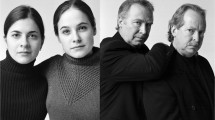Abstract
Questionnaires rating twins' physical similarity and similarity of dress were obtained from the parents of 121 identical and 70 same-sex fraternal twin pairs. Within-pair difference scores on several behavioral measures (two intelligence tests, two perceptual tests, one reading test, one test of speech articulation, and one personality inventory) were correlated with the twins' scores for physical similarity and similarity of dress. The correlations revealed no systematic relation between the similarity of appearance and the similarity of behaviors for either the identical twin pairs or the same-sex fraternal twin pairs. The assumption that twins' behaviors are more alike because they are more similar in appearance does not seem warranted.
Similar content being viewed by others
References
Bell, R. Q. (1968). A reinterpretation of the direction of effects in studies of socialization.Psychol. Rev. 75:81–95.
Cederlof, R., Friberg, L., Jonsson, E., and Kaij, L. (1961). Studies on similarity diagnosis in twins with the aid of mailed questionnaires.Acta Genet. 11:338–362.
Cohen, D. J., Dibble, E., Grawe, J. M., and Pollin, W. (1973). Separating identical from fraternal twins.Arch. Gen. Psychiat. 29:465–469.
Cohen, D. J., Dibble, E., Grawe, J. M., and Pollin, W. (1975). Reliably separating identical from fraternal twins.Arch. Gen. Psychiat. 32:1371–1375.
Cohen, D. J., Dibble, E., and Grawe, J. M. (1975). Fathers' and mothers' perceptions of children's personality. Manuscript submitted for publication.
Koch, H. L. (1966).Twins and Twin Relations, University of Chicago Press, Chicago.
Loehlin, J. C. (1973). Personality: The genes and what environment? Paper presented at the Prospects in Behavior Genetics Conference, University of Texas, March 15–17.
Matheny, A. P., Jr. (1971). Genetic determinants of the Ponzo illusion.Psychonom. Sci. 24:155–156.
Matheny, A. P., Jr. (1973). Hereditary components of response to the double trapezium illusion.Percept. Motor Skills 36:511–513.
Matheny, A. P., Jr., and Bruggemann, C. E. (1973). Children's speech: Hereditary components and sex differences.Folia Phoniatr. 25:442–449.
Nichols, R. C., and Bilbro, W. C. (1966). The diagnosis of twin zygosity.Acta Genet. 16:265–275.
Piaget, J. (1969).The Mechanisms of Perception, Basic Books. New York.
Plomin, R., Willerman, L., and Loehlin, J. C. (1976). Resemblance in appearance and the equal environments assumption in twin studies of personality traits.Behav. Genet. 6:43–52.
Porter, R. B., and Cattell, R. B. (1968).Children's Personality Questionnaire, Institute for Personality and Ability Testing, Champaign, Ill.
Price, B. (1950). Primary biases in twin studies: A review of prenatal and natal difference-producing factors in monozygotic pairs.Am. J. Hum. Genet. 2:293–352.
Reiss, A. J., Jr. (1961).Occupations and Social Status, Free Press, New York.
Smith, R. T. (1965). A comparison of socioenvironmental factors in monozygotic and dizygotic twins, testing an assumption. In S. G. Vandenberg (ed.),Methods and Goals in Human Behavior Genetics, Academic Press, New York.
Templin, M. C., and Darley, F. L. (1960).The Templin-Darley Tests of Articulation Bureau of Educational Research and Service, State University of Iowa, Iowa City, Ia.
Vandenberg, S. G. (1966). Contributions of twin research to psychology.Psychol. Bull. 66:327–352.
Wilson, R. S. (1974). Twins: Mental development in the pre-school years.Develop. Psychol. 10:580–588.
Author information
Authors and Affiliations
Additional information
This study was supported in part by funds from the Grant Foundation, Inc., the Courier-Journal and Louisville Times Foundation, the National Science Foundation (P2B 3098), and the National Institute of Mental Health (MH 23884)—R. S. Wilson, principal investigator.
Rights and permissions
About this article
Cite this article
Matheny, A.P., Wilson, R.S. & Dolan, A.B. Relations between twins' similarity of appearance and behavioral similarity: Testing an assumption. Behav Genet 6, 343–351 (1976). https://doi.org/10.1007/BF01065729
Received:
Accepted:
Issue Date:
DOI: https://doi.org/10.1007/BF01065729



